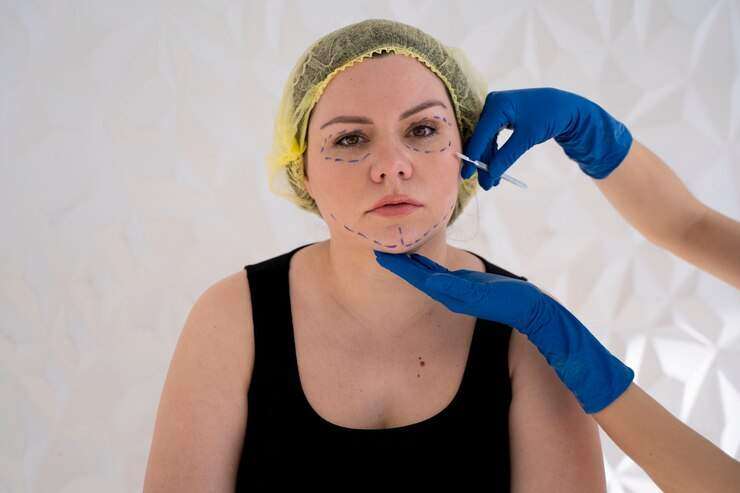
BOTOX injections are one of the easiest and least intrusive cosmetic procedures available, and the results of only one course of injections can be astonishing. A series of BOTOX injections typically take less than 10 minutes to complete, and no special preparation is required.
The procedure does not necessitate the use of anesthetics and has no anesthetic-like adverse effects. This implies that after receiving BOTOX injections, you won’t need to worry about transportation or Botox aftercare because you’ll be OK to drive and go about your day, including returning to work.
What Is Botox Treatment and How Does It Work?
Botox stands for “botulinum toxin,” a nerve poison generated by Clostridium botulinum, a bacterial food contamination. Technically, “Botox” is also the brand name of a toxin-derived medicine.
In nerve endings, botulinum toxin inhibits the release of the neurotransmitter acetylcholine. Acetylcholine serves a variety of functions in the body, including controlling voluntary muscles like those in the face.
The toxin causes potentially fatal botulism in large doses, which manifests as severe muscle paralysis in the head and neck. When taken in far lesser doses, however, it can help with a variety of medical issues. This is the “Botox treatment” as we know it today.
Botox is used to cure fine lines and wrinkles by paralyzing the facial muscles that fold the skin and contribute to the formation of these imperfections.
Because acetylcholine controls sweat gland activity, Botox can be used to reduce excessive sweating.
For some chronic skin diseases that cause extreme itching, Botox injections can be used with other treatments.
Botox is also used to treat acne because it inhibits the action of oil glands.
Dysport is a botulinum toxin alternative that BHSkin Dermatology professionals occasionally employ instead of Botox. It is more effective, but it can only be injected in certain parts of the face.
Exactly what happens during a Botox treatment?
Your dermatologist will clean the injection site before you begin your session. Botox will then be administered with the help of an extremely fine needlepoint. Depending on your face muscle arrangement and the severity of your skin disease, you may require more than one injection.
It only takes a few minutes to complete the procedure. In most cases, numbing medicine is not required. The injections may be uncomfortable, but they are bearable.
How Long Does Botox Take to Take Effect?
Botox’s therapeutic effects take a variable amount of time for each patient. By the third day after the injection, most people will notice that the treated skin has smoothed out. Around the second week, the maximum effects will occur. Muscle function returns gradually, and facial wrinkles may reappear three to four months following your therapy. By then, you should have scheduled your next Botox session to prevent the skin from reverting to its prior state.
Following a series of treatments, the target face muscles grow weaker and take longer to recover their health strength. Because maintenance treatments have an effect that lasts longer than four months, your sessions may become fewer over time.
Potential Negative Consequences
After getting BOTOX injections, it’s usual to have some moderate side effects for a few hours. Minor numbness, tingling, swelling, and bruising near injection sites are all possible side effects. These adverse effects are highly transient, lasting only a few hours.
Some people may have an allergic or hypersensitive reaction, including short-term symptoms like headaches, nausea, and flu-like symptoms. Stronger allergic reactions, such as wheezing, an itchy rash, or asthma-like symptoms, occur in a minority of persons. It’s advisable to get medical help if you’re experiencing these symptoms so you can ensure they go away promptly and safely. Getting therapy as soon as possible reduces the chance that your symptoms will impair the outcome of your BOTOX treatment.
Although dangerous side effects like trouble breathing or loss of muscular control in other body regions are extremely rare, they necessitate quick medical attention.
After BOTOX Injections, what to Avoid
You should avoid a few things for the first day or two following the operation to get the most excellent outcomes and minimize issues like toxin migration, bruising, and skin irritation.
Scratching, massaging, or rubbing the injected area is not recommended. Avoid touching such parts of the face at all costs. Touching the face might create irritation, which can lead to swelling and bruising due to the adverse effects. Rubbing or massaging the injectable BOTOX might cause it to migrate to other places of the face.
To avoid facial edema and toxin migration, avoid lying down or bending over for several hours after the treatment. Avoid lying down until bedtime if at all possible.
Avoid strenuous exercise for the first 24 hours after BOTOX injections, as this might trigger BOTOX migration and worsen any edema.
For a few days, avoid using NSAIDs such as Aleve®, Advil®, and Motrin®. These drugs can induce bruising at injection sites because they thin the blood.
For at least the first day or two after the Surgery, refrain from smoking.
Botox in the first week
The effects of BOTOX injections are visible almost immediately. Muscle relaxation takes only a few minutes, and you’ll see a considerable improvement in the fine lines and wrinkles that were treated within a few days.
Some people may experience side effects such as edema, redness, and bruising in the first few days after receiving BOTOX. Even after taking care to avoid them, these are common potential adverse effects, and they aren’t always an indicator that something is wrong with the treatment. However, it’s critical to keep touching or massaging the affected areas to a minimum.
After a few weeks,
The majority of people take two to three weeks to notice the full effects of BOTOX injections. All swelling and bruising should have subsided by now, and you should be able to observe how BOTOX has significantly reduced the appearance of fine lines and wrinkles around your forehead and other locations.
After three to four months,
The results of your BOTOX treatment will most likely start to fade three to four months following the injections. Fine lines and wrinkles gradually return to their initial state, albeit it may take several months for your face to regain its pre-treatment appearance.
ConclusionBy following Botox aftercare instructions helps in attaining satisfying results of Botox treatment. If you are unsure about Botox aftercare or what you should do, seek advice from your doctor.


